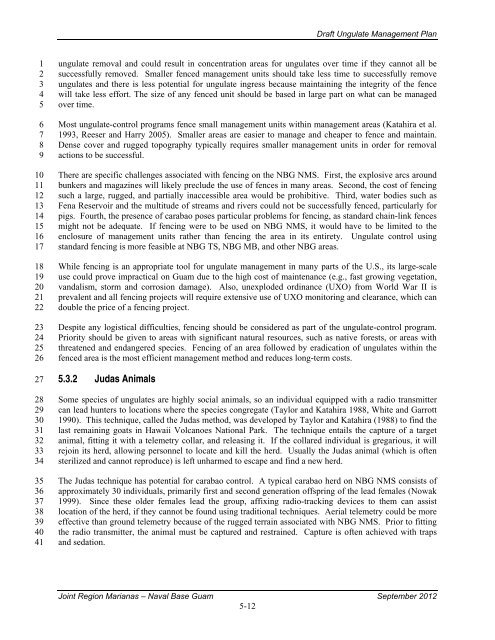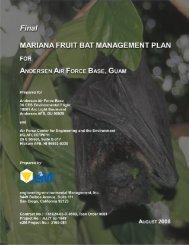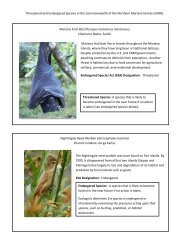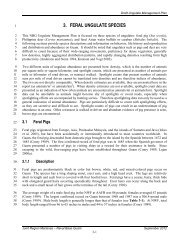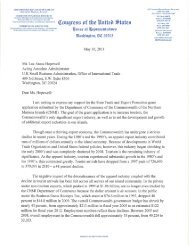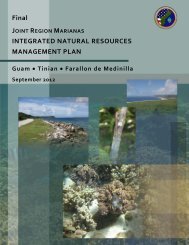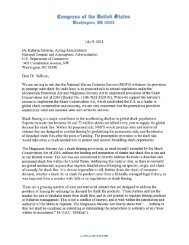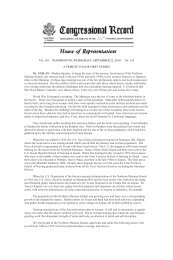4. FERAL UNGULATE SPECIES IMPACTS ON NAVY LANDS
4. FERAL UNGULATE SPECIES IMPACTS ON NAVY LANDS
4. FERAL UNGULATE SPECIES IMPACTS ON NAVY LANDS
Create successful ePaper yourself
Turn your PDF publications into a flip-book with our unique Google optimized e-Paper software.
1<br />
2<br />
3<br />
4<br />
5<br />
6<br />
7<br />
8<br />
9<br />
10<br />
11<br />
12<br />
13<br />
14<br />
15<br />
16<br />
17<br />
18<br />
19<br />
20<br />
21<br />
22<br />
23<br />
24<br />
25<br />
26<br />
27<br />
28<br />
29<br />
30<br />
31<br />
32<br />
33<br />
34<br />
35<br />
36<br />
37<br />
38<br />
39<br />
40<br />
41<br />
Draft Ungulate Management Plan<br />
ungulate removal and could result in concentration areas for ungulates over time if they cannot all be<br />
successfully removed. Smaller fenced management units should take less time to successfully remove<br />
ungulates and there is less potential for ungulate ingress because maintaining the integrity of the fence<br />
will take less effort. The size of any fenced unit should be based in large part on what can be managed<br />
over time.<br />
Most ungulate-control programs fence small management units within management areas (Katahira et al.<br />
1993, Reeser and Harry 2005). Smaller areas are easier to manage and cheaper to fence and maintain.<br />
Dense cover and rugged topography typically requires smaller management units in order for removal<br />
actions to be successful.<br />
There are specific challenges associated with fencing on the NBG NMS. First, the explosive arcs around<br />
bunkers and magazines will likely preclude the use of fences in many areas. Second, the cost of fencing<br />
such a large, rugged, and partially inaccessible area would be prohibitive. Third, water bodies such as<br />
Fena Reservoir and the multitude of streams and rivers could not be successfully fenced, particularly for<br />
pigs. Fourth, the presence of carabao poses particular problems for fencing, as standard chain-link fences<br />
might not be adequate. If fencing were to be used on NBG NMS, it would have to be limited to the<br />
enclosure of management units rather than fencing the area in its entirety. Ungulate control using<br />
standard fencing is more feasible at NBG TS, NBG MB, and other NBG areas.<br />
While fencing is an appropriate tool for ungulate management in many parts of the U.S., its large-scale<br />
use could prove impractical on Guam due to the high cost of maintenance (e.g., fast growing vegetation,<br />
vandalism, storm and corrosion damage). Also, unexploded ordinance (UXO) from World War II is<br />
prevalent and all fencing projects will require extensive use of UXO monitoring and clearance, which can<br />
double the price of a fencing project.<br />
Despite any logistical difficulties, fencing should be considered as part of the ungulate-control program.<br />
Priority should be given to areas with significant natural resources, such as native forests, or areas with<br />
threatened and endangered species. Fencing of an area followed by eradication of ungulates within the<br />
fenced area is the most efficient management method and reduces long-term costs.<br />
5.3.2 Judas Animals<br />
Some species of ungulates are highly social animals, so an individual equipped with a radio transmitter<br />
can lead hunters to locations where the species congregate (Taylor and Katahira 1988, White and Garrott<br />
1990). This technique, called the Judas method, was developed by Taylor and Katahira (1988) to find the<br />
last remaining goats in Hawaii Volcanoes National Park. The technique entails the capture of a target<br />
animal, fitting it with a telemetry collar, and releasing it. If the collared individual is gregarious, it will<br />
rejoin its herd, allowing personnel to locate and kill the herd. Usually the Judas animal (which is often<br />
sterilized and cannot reproduce) is left unharmed to escape and find a new herd.<br />
The Judas technique has potential for carabao control. A typical carabao herd on NBG NMS consists of<br />
approximately 30 individuals, primarily first and second generation offspring of the lead females (Nowak<br />
1999). Since these older females lead the group, affixing radio-tracking devices to them can assist<br />
location of the herd, if they cannot be found using traditional techniques. Aerial telemetry could be more<br />
effective than ground telemetry because of the rugged terrain associated with NBG NMS. Prior to fitting<br />
the radio transmitter, the animal must be captured and restrained. Capture is often achieved with traps<br />
and sedation.<br />
Joint Region Marianas – Naval Base Guam September 2012<br />
5-12


